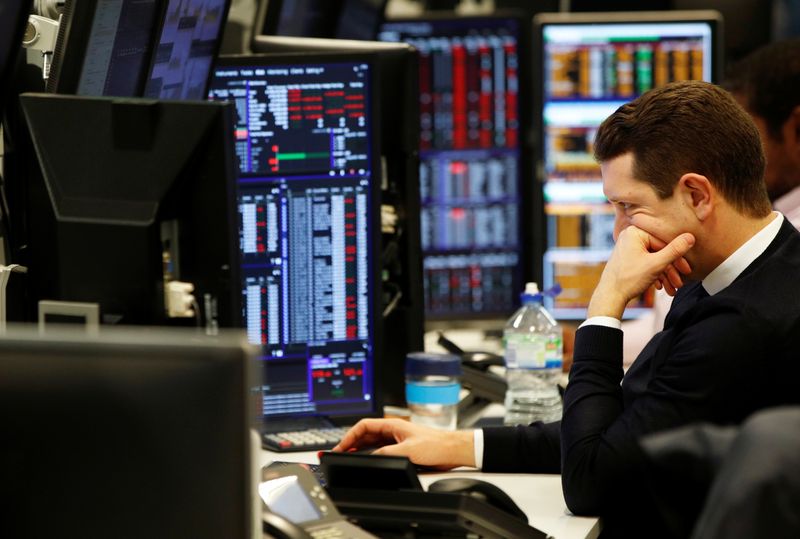
FILE PHOTO: Traders work at their desks whilst screens show market data at CMC Markets in London, Britain, January 16, 2019. REUTERS/John Sibley
October 16, 2020
By Koh Gui Qing
NEW YORK (Reuters) – Global shares rose on Friday while safe-havens such as the dollar softened as investors welcomed news that drugmaker Pfizer Inc <PFE.N> could have a coronavirus vaccine ready in the United States by the end of this year.
But concerns that a teetering recovery in the world economy could be scuttled by a resurgence in the COVID-19 pandemic in parts of Europe and the United States kept oil prices under pressure, and 10-year German bond yields near seven-month lows.
The S&P 500 <.SPX> was up 20 points, or 0.6%, at 3,503.63, while the Dow Jones Industrial Average <.DJI> jumped 253 points, or 0.9%, to 28,744.49. The Nasdaq Composite <.IXIC> climbed 43 points, or 0.3%, to 11,753.53.
Shares of Pfizer added 3.1%. The U.S. drugmaker said on Friday it could file for U.S. authorization of the COVID-19 vaccine it is developing with German partner BioNTech <22UAy.F> as early as late November.
As the global race to develop a coronavirus vaccine heats up, financial markets have tracked every twist and turn, hoping a successful deployment would hoist the world economy into a sustained rebound after a harrowing shutdown in the spring.
Some analysts say investors are now trying to look past the near-term ups and downs that accompany the development of a vaccine to focus on a likelier turnaround in 2021.
“There is a general consensus that things will be better next year,” said Rick Meckler, a partner at Cherry Lane Investments, a family investment office in New Jersey. “We go back and forth, but people are somewhat hopeful.”
The cautious optimism also benefited European shares. The pan-European STOXX 600 <.STOXX> jumped 1.3%, while shares in London <.FTSE>, Frankfurt <.GDAXI> and Paris <.FCHI> climbed between 1.5% to 2%.
For the year, however, European shares have lagged the performances of U.S. and Asian stocks.
The pan-European STOXX 600 is down 11.6% so far this year, compared to an 8.3% gain in the S&P 500 and a 5.2% rise in MSCI’s broadest index of Asia-Pacific shares outside Japan.
Asian shares also managed to notch modest gains on Friday, even though shares in China and Japan posted slim declines. The MSCI Asia-Pacific share index <.MIAPJ0000PUS> rose 0.4%, while Japan’s Nikkei <.N225> lost 0.4%.
Chinese stocks <.CSI300> edged down 0.2%, but the main stock index was up for the week for the third consecutive week.
The improved mood on trading floors dented the U.S. dollar, usually perceived as a safe-haven asset. The dollar <=USD> slipped 0.1% to 93.714 against a basket of six major currencies. [USD/]
A softer dollar helped the euro <EUR=EBS> regain some ground, with the common currency rising 0.1% to $1.1717.
Sterling was on the defensive after UK Prime Minister Boris Johnson told businesses to get ready for a no-deal Brexit in case negotiations with the European Union fail to produce a free trade agreement.
But assurances that Britain would continue to talk to European Union representatives early next week fed hopes that a deal could be reached. That gave sterling <GBP=D3> some reprieve, and it pared earlier losses to be up 0.1% at $1.2906.
Still, in a sign that the world economy is not out of the woods and investors are not unanimously upbeat about the outlook, oil prices fell on concerns that the spike in COVID-19 cases in Europe and the United States will curtail demand in two of the world’s biggest fuel-consuming regions.
“It’s a tug-of-war between risks that are well-flagged, the pandemic, the U.S. election, Brexit, and at the same time hope that these same risks can be resolved in matter of weeks or months”, said Emmanuel Cau, head of European equity strategy at Barclays.
Brent crude futures for December <LCOc1> fell 0.6% to $42.91 a barrel and U.S. West Texas Intermediate crude futures for November delivery <CLc1> slid 0.4% to $40.8. [O/R]
Also exposing market angst, Germany’s 10-year bond yield <DE10YT=RR> posted its biggest weekly drop since August and was hovering near a seven-month low of -0.63%.
Indeed, the demand for safe-haven government bonds is so robust that about 69% of the euro government bond market – worth just over 6 trillion euros – had negative yields in September, according to data from Tradeweb, a financial services company.
The 10-year U.S. Treasury yield <US10YT=RR> edged up to 0.7406% on Friday as investors took comfort in data that showed U.S. retail sales rose more than expected in September, ignoring an outlook that analysts say is threatened by pervasive unemployment, and a lack of imminent fiscal stimulus. [US/]
Many investors now expect the U.S. government to only unveil additional fiscal stimulus after the Nov. 3 election.
Dimming prospects for a near-term U.S. stimulus, and the slight pull-back from safe-haven assets weighed on gold. Gold is seen as a hedge against inflation and has benefited from the loosening of global monetary and fiscal policies.
The price of spot gold <XAU=> dipped 0.3% to $1,901.61 per ounce. [GOL/]
(Reporting by Koh Gui Qing in New York and Julien Ponthus in London; Editing by Matthew Lewis and Nick Zieminski)
